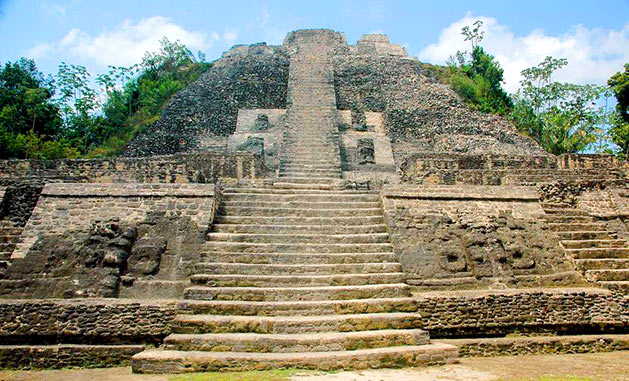SUBMERGED CROCODILE
The Lamanai Mayan Ceremonial Site

Lamanai, (Lama’an’ain – submerged crocodile in Mayan) is one of Belize’s largest Mayan ceremonial centers and is located on the banks of the New River Lagoon. Lamanai is accessible either by road, which is dull and boring, or by river from the landing at the bridge just south of Orange Walk Town, a much more interesting trip.
Lamanai was occupied continuously for over 3,000 years —probably in part because of its location on the New River which was a major trade route. Lamanai was founded in the early 16th century BC and reached its greatest importance in the PreClassic Period from the 4th century BC through the 1st century AD. During the Spanish era the Conquistadores established a major Roman Catholic church but a Mayan revolt drove the Spanish out. The site’s name was recorded by early missionaries, and documented over a millennium earlier as Lam’an’ain. Excavation was began in 1974 by the Royal Ontario Museum, its 718 known structures lie along the shore of the lagoon. Much of Lamanai’s archaeological importance is in the large, imposing Late Pre-Classic temple-pyramids which usually underlie Early Classic constructions.
The Lamanai Reserve also contains a museum, the remnants of two 16th century Spanish churches and a colonial sugar mill that was established in 1860. Set in a tropical forest with spectacular views from several of its large temples, Lamanai is an introduction into the culture of the Maya and the biological diversity of a tropical forest.
Birding At Lamanai
A popular birding site with hundreds of species, Birders will find Collared Aracaris and Toucans in the tree tops, Snail Kites, marsh birds and bats, along with Spider Monkeys and Yucatan Black Howler Monkeys (often called Baboons). Look for Royal and Sepia-caped Flycatchers, Stub-tailed Spadebills, Black-faced Ant-thrushs, Gray-collared becards, White-crowned Pparrots, Black-throated Shrikes, Tanagers, Northern Bentbills, spot- breasted and white-breasted wood wrens, white-necked puffbird, plain Xenops, Blue buntings, Olive-backed and Yellow-throated Euphonias.


